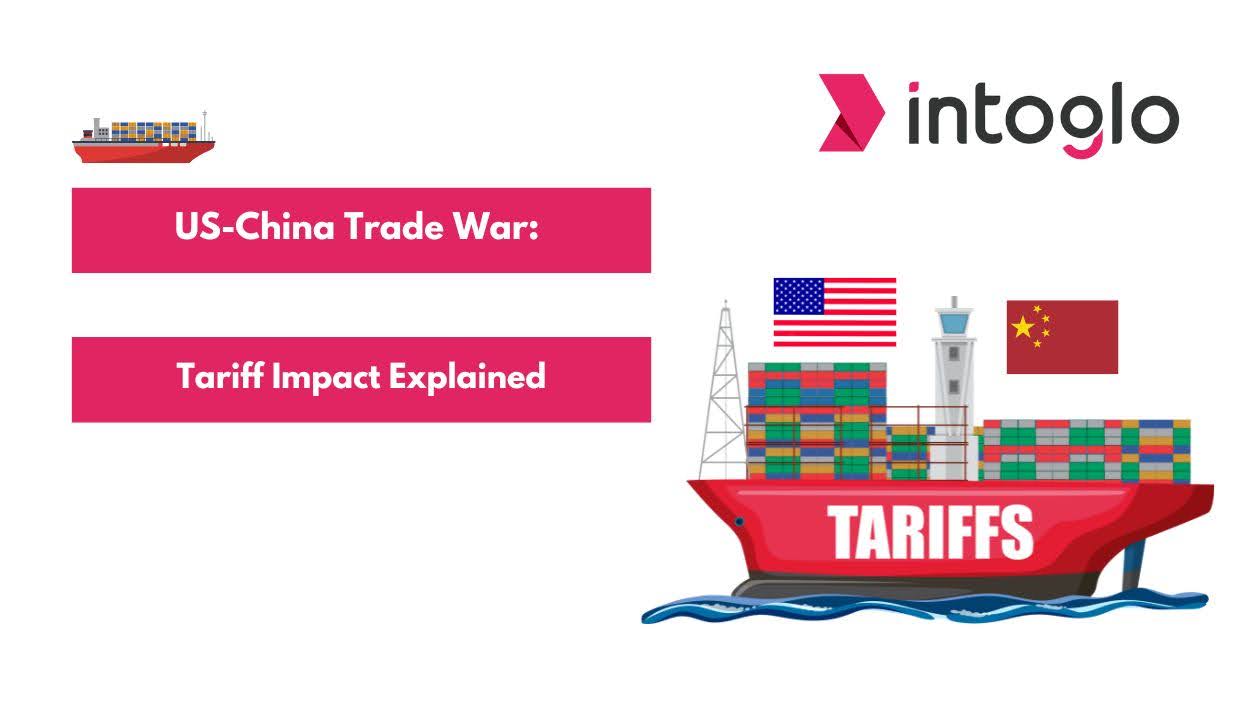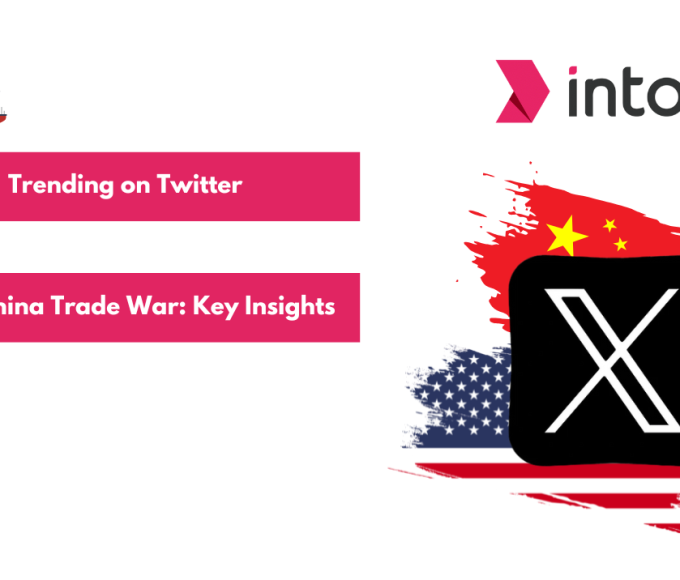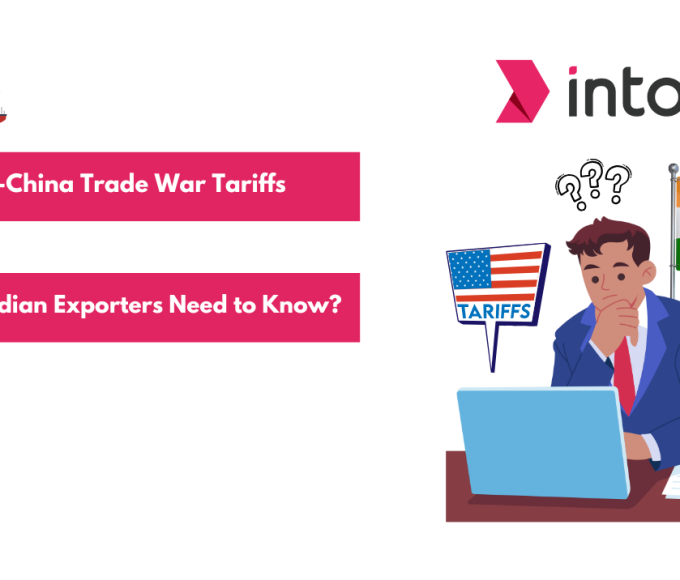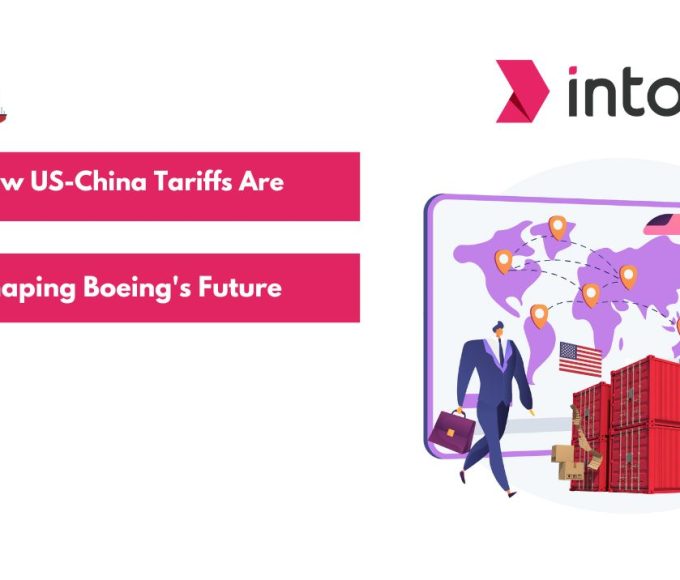The US-China trade war, started in early 2018, has evolved into a defining chapter in global commerce. What began as a series of tariff hikes aimed at addressing trade imbalances and intellectual property concerns has escalated into a full-scale economic confrontation.
By 2025, the conflict intensified under President Trump’s second term, with the United States imposing a staggering 145% tariff on Chinese goods. In retaliation, China levied a 125% tariff on American products, marking a significant escalation in trade tensions.
In the following sections, we’ll delve deeper into the impacts of US tariffs on China, including the effect on global markets and supply chains, and explore strategies to mitigate potential risks.
TL;DR
- The US-China trade war has escalated with significant tariff hikes, impacting trade between both countries.
- Tariffs on Chinese goods have reached 145%, heavily affecting Chinese exporters and global supply chains.
- The trade conflict is shifting global trade alliances, with businesses diversifying sourcing strategies.
- US consumers face price hikes, impacting everyday goods and reducing purchasing power.
- Freight forwarders like Intoglo play a crucial role in managing logistics and avoiding delays amid the tariff changes.
The Impact of US Tariffs on China
The U.S. tariffs on Chinese goods have significantly impacted China’s economy, leading to a series of economic challenges and policy responses:
1. Sharp Increase in Tariffs and Export Pressure
The United States has raised tariffs on most Chinese goods to an effective rate of 145%, a dramatic jump from the initial 10% just months earlier. This surge in tariffs has put severe pressure on Chinese exporters, especially small and medium-sized manufacturers of consumer goods such as electronics, clothing, and toys, which are heavily reliant on the US market for sales.
2. Export Decline and Economic Slowdown
In 2024, China exported $524.66 billion in goods to the US, representing nearly 15% of its total exports. With tariffs at 145%, many Chinese firms find it difficult to remain competitive, forcing some to raise prices for American consumers or halt shipments entirely. J.P. Morgan projects that these tariffs could reduce China’s GDP growth to 4.4% in 2025, down by 0.2 percentage points from earlier forecasts. Goldman Sachs has also cut its GDP growth outlook for China to 4%, citing weaker exports and global demand.
3. Employment and Income Effects
The impact extends beyond trade figures. Approximately 10 to 20 million Chinese workers are tied to export businesses serving the US market. Studies indicate that about 2.5% of China’s population has been exposed to US tariffs, with affected individuals seeing their incomes drop by an average of 2.52% and manufacturing employment declining by 1.62%. This loss in income and jobs reduces domestic consumption and tax revenue, amplifying the negative effect on China’s GDP.
4. Decline in Bilateral Trade
The US tariffs led to a sustained drop in trade between the two countries. For six consecutive months in 2019, China’s exports to the US fell by 2.6% annually between January and June, while US exports to China plummeted by 25.7% over the same period.
5. Broader Economic and Global Effects
The tariffs not only disrupt China’s economy but also have global repercussions. Higher costs for US consumers can lead to inflation and reduced demand, which in turn slows global economic growth. J.P. Morgan estimates that a 10% universal tariff combined with a 110% tariff on China could reduce global GDP by 1%. Additionally, retaliatory measures by China further dampen trade and investment flows between the two economies.
6. Slowdown in Two-Way Investment
The heightened trade tensions and policy uncertainty significantly slowed cross-border investment. In the first half of 2019, combined direct investment and venture capital flows between the US and China dropped to $13 billion, marking an 18% decline from the previous six months and the lowest level since 2014.
Chinese foreign direct investment (FDI) in the US remained weak, totaling just $3.1 billion in the first half of 2019, as acquisitions dried up and political risks mounted. Meanwhile, US FDI in China held steady in some sectors but began to unravel in others, with investors growing more cautious amid escalating frictions.
As per the Chinese Ministry of Commerce, China’s direct investment in the U.S. dropped by 10% in 2018, totaling $5.79 billion, while the U.S. invested $3.45 billion in China during the same period. In early 2019, US investment in China saw a temporary uptick, but Chinese investment in the US continued to fall sharply
Summary of Key Statistics:
- China’s exports to the US (Jan–June 2019): -2.6% year-on-year
- US exports to China (Jan–June 2019): -25.7% year-on-year
- China’s direct investment in the US (2018): $5.79 billion (-10% YoY)
- US direct investment in China (2018): $3.45 billion
- US investment in China (Jan–Apr 2019): $1.23 billion (+24.3% YoY)
- Chinese investment in the US (Jan–Apr 2019): $1.96 billion (-20% YoY)
These figures highlight how US tariffs and the resulting trade tensions have led to a notable contraction in both trade and investment between the two countries, impacting businesses and economic growth on both sides.
Ready to streamline your India-to-USA shipments?
Call today for smooth logistics! syncWhat are China’s Retaliation and Countermeasures?
China has responded to escalating US tariffs with a comprehensive set of countermeasures that go well beyond reciprocal tariffs. In addition to imposing high retaliatory tariffs-reaching up to 125% on American goods, China has expanded non-tariff barriers to block US imports entirely and introduced new export restrictions on critical minerals, particularly rare earth elements, where China dominates global refining and production
China has also taken action against U.S. companies by placing them on its Export Control List and Unreliable Entity List, limiting their capacity to operate in China or engage with Chinese companies. Regulatory measures have involved initiating antitrust and antidumping probes against major U.S. corporations and halting imports of essential U.S. agricultural goods, including soybeans, poultry, and sorghum, from certain exporters. Additionally, China introduced a tariff exemption system to mitigate the impact on certain US imports and established an “unreliable entities” list targeting foreign companies deemed a threat to Chinese interests.
Beyond direct retaliation, China has accelerated efforts to diversify its trade relationships by strengthening economic ties with other countries. This includes pursuing new trade agreements, expanding partnerships within the Regional Comprehensive Economic Partnership (RCEP), and increasing exports to markets in Southeast Asia, Europe, and Africa.
These strategies aim to reduce China’s dependence on the US market, stabilize export growth, and mitigate the broader economic impact of the ongoing trade tensions.
The Global Consequences of the U.S.-India Trade Disputes
The U.S.-China trade war has far-reaching consequences beyond the borders of the two countries involved. As global markets and supply chains adjust to the tariffs and economic uncertainty, other major economies are also responding, with shifts in trade alliances and policies.
1. Impact on Global Supply Chains
China’s evolving trade strategy and global supply chain role have triggered significant shifts. Rising labor costs and trade tensions have prompted some manufacturing, especially in apparel and electronics, to relocate to countries like Vietnam, Bangladesh, and India.
However, China’s unmatched infrastructure and logistics continue to make it a central player, particularly in complex sectors such as solar energy and electronics, where it dominates upstream supply and processing.
2. Reactions of Other Major Economies
Other major economies have responded by accelerating their own “de-risking” and supply chain diversification efforts. The US and EU have implemented policies to encourage reshoring and “friendshoring,” especially in sensitive sectors like semiconductors, green technologies, and critical minerals. These efforts include high tariffs, local content requirements, and substantial industrial subsidies, aiming to reduce dependence on Chinese suppliers.
However, alternative production hubs often lack China’s scale and efficiency, slowing the pace of diversification and sometimes raising costs for global manufacturers
Implications for Global Trade Alliances
These shifts are reshaping global trade alliances. China’s deepening ties with ASEAN, the EU, and BRI partners are strengthening new economic blocs, while the US and EU are forging closer trade and investment partnerships with each other and with countries like India, Vietnam, and Mexico. This realignment is creating both winners and losers: emerging markets in Asia and Eastern Europe are gaining from trade relocation, while countries heavily integrated into China-centered supply chains may face losses as production moves elsewhere.
Want competitive pricing on FCL shipping from India to the USA?
Request a quote now! syncWTO Dispute Settlement: Challenges and Cases
The World Trade Organization (WTO) has played a central role in mediating the escalating US-China trade conflict, with both countries filing multiple challenges against each other’s tariff measures.
In April 2018, China brought a case to the WTO’s dispute settlement mechanism over US Section 301 tariffs, arguing they violated core WTO rules such as Most-Favored-Nation (MFN) treatment and bound tariff rates.
In September 2020, a WTO panel ruled in favor of China, finding the US tariffs inconsistent with WTO obligations. However, the US appealed the decision, but the appeal process remains stalled due to the paralysis of the WTO Appellate Body, leaving the case unresolved.
Similarly, the US successfully challenged China’s retaliatory tariffs on US goods, with a WTO panel ruling that China’s measures were not consistent with WTO rules. These cases highlight both the importance and the current limitations of the WTO’s dispute settlement system, which has been hampered by procedural deadlock and delays.
On April 8, 2025, China requested consultations with the U.S., alleging that the additional duties imposed under the International Emergency Economic Powers Act (IEEPA) violate WTO rules. The U.S. had implemented a 34% reciprocal tariff on Chinese imports, prompting Beijing to impose a 34% tariff on all U.S. goods in retaliation. China argues that these measures are inconsistent with the WTO’s principles of non-discrimination and proportionality.
These cases highlight both the importance and the current limitations of the WTO’s dispute settlement system, which has been hampered by procedural deadlock and delays.
Strategies for Resolving Trade Tensions
In the face of escalating trade disputes, such as the U.S.-China trade war, nations are exploring various strategies to de-escalate tensions and restore stability to global markets.
1. Diplomatic Engagement and Negotiation
Direct dialogue remains a cornerstone in resolving trade conflicts. For example, the U.S. recently agreed to reduce tariffs on certain Chinese goods to 30% for a 90-day period as a temporary measure to ease tensions. However, it remains uncertain what will happen once this period ends. High-level talks continue as both countries seek common ground to reduce the economic strain caused by unilateral trade measures.
2. Strengthening the WTO’s Dispute Settlement Mechanism
The World Trade Organization (WTO) plays a pivotal role in adjudicating trade disputes. However, its effectiveness has been challenged due to the paralysis of the Appellate Body. Reform discussions are underway to enhance the dispute settlement system, ensuring it can impartially resolve conflicts and maintain the integrity of international trade rules.
3. Promoting Multilateral Trade Agreements
Engaging in multilateral trade agreements can help mitigate the impact of bilateral disputes. Such agreements foster cooperation among multiple countries, creating a platform for collective problem-solving and reducing the likelihood of protectionist policies. The WTO’s role in facilitating these agreements is crucial for maintaining a balanced global trade environment.
4. Encouraging Regional Trade Partnerships
In response to global trade tensions, countries are increasingly turning to regional trade partnerships. These alliances allow nations to strengthen economic ties within their region, providing a buffer against external trade shocks. While regional agreements can offer immediate benefits, they should complement, not replace, the multilateral trading system.
Looking for real-time tracking and AI-powered compliance for your exports?
Reach out to our experts!Conclusion
The ongoing U.S.-China trade war and shifting tariff regulations present significant challenges for exporters. Adapting to these changes is crucial for maintaining smooth operations and avoiding unnecessary delays.
As tariffs continue to shift the dynamics of global trade, businesses looking to maintain smooth operations must adapt quickly. Freight forwarders play a critical role in helping companies manage the complexities of international logistics, especially when shipping goods between countries like India and the USA. By utilizing the expertise of a reliable freight forwarder, businesses can avoid costly delays and ensure compliance with new tariff regulations.
If you’re looking to efficiently ship products from India to the USA amidst the ongoing trade tensions, partnering with a trusted freight forwarder like Intoglo can make all the difference. Our comprehensive services—ranging from door-to-door FCL Shipping, handling customs documentation to offering competitive shipping rates—help ensure that your goods reach their destination without unnecessary complications.
With the evolving tariff environment, Intoglo is well-equipped to guide your business through these challenges, ensuring timely and cost-effective deliveries.
Why Choose Intoglo?
Whether you’re a first-time exporter or a seasoned business looking for optimal shipping solutions, Intoglo’s integrated services, including:
- AI-powered HTS code scanning
- Clear, no-hidden-cost pricing
- End-to-end visibility
- Comprehensive support considering India and USA time zones
With the U.S.-China trade relationship remaining uncertain, many U.S. buyers and suppliers are actively diversifying their sourcing strategies. This shift creates a significant opportunity for Indian exporters to expand their footprint in the U.S. market. Intoglo’s deep expertise in India-to-USA logistics ensures you can confidently tap into this growing demand, providing a smooth, reliable shipping experience that keeps your business ahead.
Ready to streamline your India-to-USA shipments? Contact Intoglo’s expert team today for seamless logistics solutions tailored to your business needs.
FAQs
1. What are the current tariff rates between the US and China?
Answer: As of April 2025, the US has imposed tariffs of 145% on most imports from China, while China has retaliated with tariffs of up to 125% on American goods. These rates are among the highest ever seen in bilateral trade and have made many goods unviable for cross-border trade.
2. How have these tariffs affected trade volumes between the two countries?
Answer: US imports of goods and services from China have collapsed by about 90% under the current tariff regime, as nearly all Chinese goods are now subject to prohibitive tariffs. This has led to a dramatic contraction in bilateral trade flows.
3. What is the impact of the trade war on US consumers and businesses?
Answer: The 2025 tariffs have raised the overall US price level by 3% in the short run, resulting in an average loss of purchasing power of $4,900 per household (in 2024 dollars). Key consumer goods like shoes and apparel have seen price increases of 87% and 65% respectively in the short run, with long-run increases of 29% and 25% even after consumers shift to alternatives.
4. Are there any signs that tariffs might be reduced soon?
Answer: There are ongoing discussions about lowering tariffs. The US is considering reducing tariffs on Chinese imports to a range of 50%–54%, down from the current 145%, as part of negotiations with China. However, any reduction is likely to be gradual and contingent on progress in trade talks.
5. How is the trade war affecting the global economy and other countries?
Answer: The US-China trade war has global repercussions, slowing economic growth, raising inflation risks, and prompting other nations to adjust their trade and investment strategies. Major economies and trading partners have imposed their own retaliatory tariffs, and global supply chains are being restructured as companies seek alternatives to China and the US for sourcing and markets.









Leave a comment